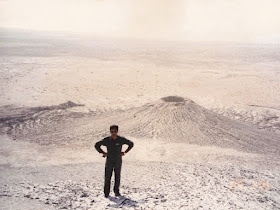Pakistani Province Baluchistan
is gifted with a diverse landscape. Among many geological wonders here, one big
attraction is the presence of numerous mud volcanoes. Baluchistan has more than
80 active mud volcanoes in the Miani Hor-Hingol Valley region. Chandragup
Mud Volcano is most famous mud volcano, also called Chandar-Gup or
Chandrakup. The highest Concentration is just three hours’ drive from Makran
Coastal highway towards North in Hingol National Park, Baluchistan, Pakistan. Instead
of lava, ash, and sulfur dioxide, these volcanoes spew mud and methane. On rare
occasions, the gas plumes spontaneously ignite, shooting flames high into the
sky.
The Chandragup Mud Volcano height
is between 800 to 1500 feet. Mud volcanoes hold clues to underground mineral
resources, not to mention important geological and seismic information. It is
considered the holy place of Hindus devotees who like to stay here for pilgrims
on their way to the shrine of Devi Hinglaj. This is also a potential tourist
attraction for adventure junkie. Another word which locally mentions this group
of volcanoes is ‘Chandra coop’ which means Volcanoes of the Moon. Mud volcanoes
have roots that go several kilometers underground and act as safety valves for
high underground pressure. Mud volcanoes are generally not considered to be hazardous.
Azerbaijan has the largest concentration of mud volcanoes in the world.
Scientific studies out in this
area and find the presence of huge deposits of methane underneath the surface. Unfortunately,
the gas deposits are in a solid form called methane hydrates. Perhaps in the
future, the mud volcanoes might answer Pakistan’s energy needs. Dirt tracks
leads to Chandragup Mud Volcano, only navigable in 4x4 vehicles. It is
extremely hard to track here due to tiny sand flies. Who winged gnats seek
exposed skin and their bites leave large, red itchy bumps that may turn into a
rash. According to some claims, Chandragup mud volcano in Jhal Jhao tehsil of
Balochistan is the largest and highest volcano in the world.
Moreover keep in mind that these sandflies are notorious
to carry a host of viruses and people are known to have died from complications
arising from sand fly bites. The individual should be fit enough as far as physical
condition and vehicles is well equipped. This is extremely remote location and
isolated from civilization, so no chance of rescue if required. Make sure, no mobile service available within
50 kilometers in any direction. Another famous Mud volcano “Jabl-ul-Ghurab” is very
close to Chandragup. Moreover, ancient Hindu temple ‘Hinglaj temple’ or ‘Nani
Temple’ is also located near to Chandragup Mud Volcano. It is reported that
during the infamous 8.1 intensity earthquake of Balochistan which occurred on
May 31, 1935 a mud volcano erupted Northwest of Quetta, near the town of Surab
and kept spewing out mud for 9 hours continuously.








No comments:
Post a Comment